Ad
Convolutional Neural Network and RNN for OCR problem.
- 1. SEQUENCE-TO-SEQUENCE LEARNING USING DEEP LEARNING FOR OPTICAL CHARACTER RECOGNITION Advisor Dr. Devinder Kaur Presented By Vishal Vijay Shankar Mishra
- 2. AGENDA • Problem Statement Converting Mathematical Equations into Latex representation. • Approach (Deep Learning Techniques) Convolutional Neural Network (CNN) Recurrent Neural Network (RNN) Long Term-Short Memory (LTSM) Attention Model • Introduction to CNN Gist of Neural Network Architecture of CNN • CNN layers Convolution Layer Non-Linear Activation Layer (ReLu) Pooling Layer • Hyper-Parameters. • Introduction to RNN Architecture of RNN Working of RNN RNN Example • Drawback of RNN • LSTM Architecture of LSTM Working of LSTM LSTM Example • Proposed Model • Results and Future work • Conclusion
- 3. AGENDA • Problem Statement Converting Mathematical Equations into Latex representation. • Approach (Deep Learning Techniques) Convolutional Neural Network (CNN) Recurrent Neural Network (RNN) Long Term-Short Memory (LTSM) Attention Model • Introduction to CNN Gist of Neural Network Architecture of CNN • CNN layers Convolution Layer Non-Linear Activation Layer (ReLu) Pooling Layer • Hyper-Parameters. • Introduction to RNN Architecture of RNN Working of RNN RNN Example • Drawback of RNN • LSTM Architecture of LSTM Working of LSTM LSTM Example • Proposed Model • Results and Future work • Conclusion
- 4. PROBLEM STATEMENT •In this thesis, I have implemented a sequence-to- sequence analysis using Deep Learning for Optical Character Recognition. •I have used the images of the mathematical equations to convert it into LATEX representation.
- 5. AGENDA • Problem Statement Converting Mathematical Equations into Latex representation. • Approach (Deep Learning Techniques) Convolutional Neural Network (CNN) Recurrent Neural Network (RNN) Long Term-Short Memory (LTSM) Attention Model • Introduction to CNN Gist of Neural Network Architecture of CNN • CNN layers Convolution Layer Non-Linear Activation Layer (ReLu) Pooling Layer • Hyper-Parameters. • Introduction to RNN Architecture of RNN Working of RNN RNN Example • Drawback of RNN • LSTM Architecture of LSTM Working of LSTM LSTM Example • Proposed Model • Results and Future work • Conclusion
- 6. APPROACH (DEEP LEARNING TECHNIQUES) • To accomplish this research work, I have used the following deep learning techniques. Convolutional Neural Network (CNN) Recurrent Neural Network (RNN) Long Term-Short Memory (LSTM) Attention model. • In the subsequent slides, I’ll try to give the gist of the techniques.
- 7. WHAT IS DEEP NEURAL NETWORK? • Deep Neural Networks are those networks that have more than 2 layer to perform the task.
- 8. WHY DO WE NEED DEEP NEURAL NETWORK? • Neural nets tend to be computationally expensive for data with simple patterns; in such cases you should use a model like Logistic Regression or an SVM. • As the pattern complexity increases, neural nets start to outperform other machine learning methods. • At the highest levels of pattern complexity –for example high-resolution images • – neural nets with a small number of layers will require a number of nodes that grows exponentially with the number of unique patterns. Even then, the net would likely take excessive time to train, or simply would fail to
- 9. AGENDA • Problem Statement Converting Mathematical Equations into Latex representation. • Approach (Deep Learning Techniques) Convolutional Neural Network (CNN) Recurrent Neural Network (RNN) Long Term-Short Memory (LTSM) Attention Model • Introduction to CNN Gist of Neural Network Architecture of CNN • CNN layers Convolution Layer Non-Linear Activation Layer (ReLu) Pooling Layer • Hyper-Parameters. • Introduction to RNN Architecture of RNN Working of RNN RNN Example • Drawback of RNN • LSTM Architecture of LSTM Working of LSTM LSTM Example • Proposed Model • Results and Future work • Conclusion
- 10. WHY CONVOLUTIONAL NEURAL NETWORK?
- 11. WHY CONVOLUTIONAL NEURAL NETWORK?
- 12. WHY CONVOLUTIONAL NEURAL NETWORK?
- 13. WHY CONVOLUTIONAL NEURAL NETWORK?
- 14. WHY CONVOLUTIONAL NEURAL NETWORK?
- 15. INTRODUCTION TO CNN • Architecture of CNN
- 16. WORKING OF CNN
- 17. WORKING OF CNN
- 18. WORKING OF CNN
- 19. WORKING OF CNN
- 20. WORKING OF CNN
- 21. WORKING OF CNN
- 22. WORKING OF CNN
- 23. WORKING OF CNN
- 24. WORKING OF CNN
- 25. WORKING OF CNN
- 26. WORKING OF CNN
- 27. WORKING OF CNN
- 28. WORKING OF CNN
- 29. WORKING OF CNN
- 30. WORKING OF CNN
- 31. WORKING OF CNN
- 32. WORKING OF CNN
- 33. WORKING OF CNN
- 34. AGENDA • Problem Statement Converting Mathematical Equations into Latex representation. • Approach (Deep Learning Techniques) Convolutional Neural Network (CNN) Recurrent Neural Network (RNN) Long Term-Short Memory (LTSM) Attention Model • Introduction to CNN Gist of Neural Network Architecture of CNN • CNN layers Convolution Layer Non-Linear Activation Layer (ReLu) Pooling Layer • Hyper-Parameters. • Introduction to RNN Architecture of RNN Working of RNN RNN Example • Drawback of RNN • LSTM Architecture of LSTM Working of LSTM LSTM Example • Proposed Model • Results and Future work • Conclusion
- 35. LAYERS IN CNN
- 64. NON-LINEAR ACTIVATION LAYER (RELU) • ReLU is a non-linear activation function, which is used to apply elementwise non-linearity. • ReLU layer applies an activation function to each element, such as the max(0, x) thresholding to zero.
- 68. AGENDA • Problem Statement Converting Mathematical Equations into Latex representation. • Approach (Deep Learning Techniques) Convolutional Neural Network (CNN) Recurrent Neural Network (RNN) Long Term-Short Memory (LTSM) Attention Model • Introduction to CNN Gist of Neural Network Architecture of CNN • CNN layers Convolution Layer Non-Linear Activation Layer (ReLu) Pooling Layer • Hyper-Parameters. • Introduction to RNN Architecture of RNN Working of RNN RNN Example • Drawback of RNN • LSTM Architecture of LSTM Working of LSTM LSTM Example • Proposed Model • Results and Future work • Conclusion
- 69. HYPER-PARAMETERS • Convolution • Filter Size • Number of Filters • Padding • Stride • Pooling • Filter Size • Stride • Fully Connected • Number of neurons
- 70. AGENDA • Problem Statement Converting Mathematical Equations into Latex representation. • Approach (Deep Learning Techniques) Convolutional Neural Network (CNN) Recurrent Neural Network (RNN) Long Term-Short Memory (LTSM) Attention Model • Introduction to CNN Gist of Neural Network Architecture of CNN • CNN layers Convolution Layer Non-Linear Activation Layer (ReLu) Pooling Layer • Hyper-Parameters. • Introduction to RNN Architecture of RNN Working of RNN RNN Example • Drawback of RNN • LSTM Architecture of LSTM Working of LSTM LSTM Example • Proposed Model • Results and Future work • Conclusion
- 71. INTRODUCTION TO RNN • RNNs are a type of artificial neural network designed to recognize the patterns in sequences of data. It is used to process the data sequentially. • Why can’t we accomplish this task with Feed forward network? • The drawback of feed forward network is that, it doesn't remember the inputs over the period of time. • To process the data sequentially we need a network that behave recurrently. • Architecture of RNN RNN have loop
- 72. • RNNs are not all that different than Neural Network. RNN can be thought of as multiple copies of the same network, each passing a message to a successor. An unrolled RNN is shown below. • In fast last few years, there have been incredible success applying RNNs to a variety of problems: speech recognition, language modeling, translation, image captioning…. The list goes on. An Unrolled RNN
- 73. DRAWBACK OF AN RNN • RNN has a problem of long term dependency. It doesn’t remember the inputs after certain time steps. • This problem occurs due to gradient exploding or gradient vanishing while performing backpropagation. • I’ll try to example this problem with an example. • Let’s consider a language model trying to predict the next word based on the previous ones. • For example “the clouds are in the sky ”. So in order to predict the sky we don’t need any further context. In such cases, where the gap between the relevant information and the place that it’s needed is small, RNNs can learn to use the past information
- 74. • But there are also cases where we need to know more context of the input. • For example “I grew up in France ……………………………. I speak fluent French” . • Unfortunately, as that gap grows, RNNs become unable to learn to connect the information. • This happens due to vanishing gradient and exploding gradient problem.
- 77. HOW TO OVERCOME THESE CHALLENGES? • For Vanishing gradient we can use, ReLu activation function: We can use activation functions like ReLU, which gives output one while calculating gradient. LSTM, GRUs : Different network architectures that has been specially designed can be used to combat this problem. • For Exploding gradient we can use, Clip gradients at threshold: clip the gradient when it goes higher than a threshold.
- 78. AGENDA • Problem Statement Converting Mathematical Equations into Latex representation. • Approach (Deep Learning Techniques) Convolutional Neural Network (CNN) Recurrent Neural Network (RNN) Long Term-Short Memory (LTSM) Attention Model • Introduction to CNN Gist of Neural Network Architecture of CNN • CNN layers Convolution Layer Non-Linear Activation Layer (ReLu) Pooling Layer • Hyper-Parameters. • Introduction to RNN Architecture of RNN Working of RNN RNN Example • Drawback of RNN • LSTM Architecture of LSTM Working of LSTM LSTM Example • Proposed Model • Results and Future work • Conclusion
- 79. LONG SHORT-TERM MEMORY (LSTM) • Long Short Term Memory network – usually just called “LSTM” – are a special kind of RNN • They are capable of learning long-term dependencies.
- 80. ARCHITECTURE OF LSTM • Why LSTM is different then RNN, because LSTM has cell state that deals with long term dependencies.
- 81. WORKING OF LSTM • Step 1: The first step in the LSTM is to identify those information that are not required and will be thrown away from the cell state. This decision is made of neural network with sigmoid activation function called forget gate layer. • 𝑊𝑓 = weight • ℎ 𝑡−1 = output from the previous time step • 𝑋𝑡 = New input • 𝑏𝑓 = bias 𝑓𝑡 = 𝑠𝑖𝑔𝑚𝑜𝑖𝑑(𝑊𝑓 ℎ 𝑡−1, 𝑋𝑡 + 𝑏𝑓
- 82. WORKING OF LSTM • Step 2: The next step is to decide, what new information we’re going to store in the cell state. This whole process comprises of following steps. A NN layer with sigmoid sigmoid called the “input gate layer” decides which values will be updated. Next, a NN layer with tanh activation creates a new vector that could be added to the state. • In the next step, we’ll combine these two to • V update the state. 𝑖 𝑡 = 𝑠𝑖𝑔𝑚𝑜𝑖𝑑(𝑊𝑖 ℎ 𝑡−1, 𝑋𝑡 + 𝑏𝑖 𝐶𝑡′ = 𝑡𝑎𝑛ℎ(𝑊𝑐 ℎ 𝑡−1, 𝑋𝑡 + 𝑏 𝑐
- 83. WORKING OF LSTM • Step 3: Now, we will update the old cell states, Ct-1 into the new cell state Ct. First, we multiply the old state (Ct-1) by ft, forgetting the things we decided to forget earlier. Then, we add it * 𝐶𝑡 ′ . This is the new vector values, scaled by how much we decided to update each cell state value. 𝐶𝑡 = 𝑓𝑡 ∗ 𝐶𝑡−1 + 𝑖 𝑡 ∗ 𝐶𝑡′
- 84. WORKING OF LSTM • Step 4: We will run a sigmoid layer which decides what parts of the cell state we’re going to output. Then, we put the cell state through tanh (push the values to be between -1 and 1) and multiply it by the output of the sigmoid gate, so that we only output the parts we decided to. 𝑂𝑡 = 𝑠𝑖𝑔𝑚𝑜𝑖𝑑(𝑊𝑜 ℎ 𝑡−1, 𝑋𝑡 + 𝑏 𝑜 ℎ 𝑡 = 𝑂𝑡 ∗ tan h( 𝐶𝑡 s
- 85. PROPOSED LSTM VARIANT WITH PEEPHOLE CONNECTION • The easiest but very powerful solution to the conventional LSTM unit is to introduce a weighted “peephole” connections from the cell state unit (Ct-1) to all the gates in the same memory unit. The peephole connections allow every gate to assess the current cell state even though the output gate is closed.
- 86. STOCHASTIC “HARD” ATTENTION MODEL • With an attention mechanism, the image is first divided into n, parts, and we compute with a CNN representations of each part y1,y2………yn. When LSTM is generating a new word, the attention mechanism is focusing on the relevant part of the image, so the decoder only uses specific parts of the image. • In stochastic process like Hard attention mechanism, rather than using all the hidden states yt as an input for the decoding, the process finds the probabilities of a hidden state with respect to location variable 𝑠𝑡. The gradients are obtained by reinforcement learning.
- 87. AGENDA • Problem Statement Converting Mathematical Equations into Latex representation. • Approach (Deep Learning Techniques) Convolutional Neural Network (CNN) Recurrent Neural Network (RNN) Long Term-Short Memory (LTSM) Attention Model • Introduction to CNN Gist of Neural Network Architecture of CNN • CNN layers Convolution Layer Non-Linear Activation Layer (ReLu) Pooling Layer • Hyper-Parameters. • Introduction to RNN Architecture of RNN Working of RNN RNN Example • Drawback of RNN • LSTM Architecture of LSTM Working of LSTM LSTM Example • Proposed Model • Results • Conclusion and Future work
- 88. PROPOSED MODEL
- 89. PROPOSED MODEL
- 90. • Original Image • Predicted Latex: • Rendered Predicted Image: Actual Test results on Test set:
- 91. RESULTS • The proposed method is compared with the previous two methods called INFTY and WYGIWYS on the bases of BLEU (Bilingual evaluation understudy) metric and Exact Match. BLEU is a metric to evaluate the quality for the predicted Latex markup representation of the image. Exact Match is the metric which represents the percentage of the images classified correctly. • It can be seen that the proposed method scores better than the previous methods. The proposed model generated results close to 76% which is the highest in this research area. Previously, the highest result was around 75% achieved by WYGIWYS (What You Get Is What You See) model. The BLEU and Exact Match scores of the proposed model are slightly above the existing model however, this is a significant achievement considering the low GPU resources and small dataset. Model Preprocessing BLEU Exact Match INFTY - 51.20 15.60 WYGIWYS Tokenize 73.71 74.46 PROPOSED MODEL Tokenize 75.08 75.87
- 92. Actual Test results on Test set:
- 93. FUTURE WORK. • For possible future work, this research can be scaled from printed mathematical formulas images to the hand written mathematical formulas images. To recognize the hand written mathematical formulas, one can implement the bidirectional LSTM with CNN • This model can be used to solve the mathematical question based on formulas. • An API (Application Program Interface) can be created to solve the mathematical problems.
- 94. REFERENCES. [1] R. 1. Anderson, Syntax-directed recognition of handprinted mathematics., CA: Symposium, 1967. [2] K. Cho, A. Courville and Y. Bengio, "Describing Multimedia Content Using Attention-Based Encoder-Decoder Networks," in IEEE, CA, 2015. [3] A. K. a. E. Learned-Miller, "Learning on the Fly: Font-Free Approaches to Difficult OCR Problems," MA, 2000. [4] D. Lopresti, "Optical Character Recognition Errors and Their Effects on Natural Language Processing," International Journal on Document Analysis and Recognition, 19 12 [5] WILDML, "WILDML," [Online]. Available: http://www.wildml.com/2015/09/recurrent-neural-networks-tutorial-part-1-introduction-to-rnns/. [6] S. a. S. J. Hochreiter, "Long Short-Term Memory. Neural Computation," 1997. [7] S. Yan, "Understanding LSTM and its diagrams," Software engineer & wantrepreneur. Interested in computer graphics, bitcoin and deep learning., 13 03 2016. [Online]. [1] https://medium.com/@shiyan/understanding-lstm-and-its-diagrams-37e2f46f1714. [8] C. R. a. D. P. W. Ellis, "FEED-FORWARD NETWORKS WITH ATTENTION CAN SOLVE SOME LONG-TERM MEMORY PROBLEMS," ICLR, 2016. [9] a. F.-F. L. Karpathy, Image captioning., 2015. [10] F. A. Gers, N. N. Schraudolph and J. Schmidhuber, "Learning Precise Timing with LSTM Recurrent Networks," Journal of Machine Learning Reserach, 8 2002.
Editor's Notes
- #15: In addition these type of networks don’t take into account or understand the relation between the space and the pixels in the images. Particular within images we know that pixels in near by space are much more correlated than those further part. So these networks by being fully connected don’t take this sort of consideration into account. So what we are going to do by our understanding about space relation, we are going to delete some connections
- #17: . So instead of fully connected layer. Now we have the units in the hidden layer are connected to the near by pixels in the input layer.
- #18: Now instead of weight we call these values as filters
- #74: Point 5 it is obvious that the next word is going to be sky. In such a ca
- #78: Truncated BTT RMSprop to adjust learning rate.




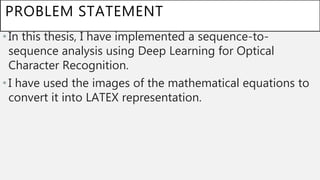
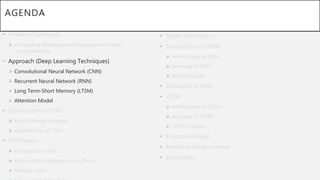

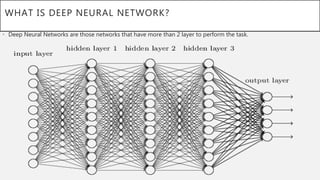










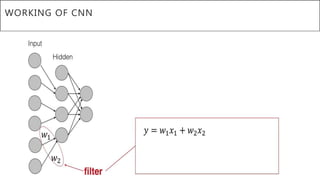



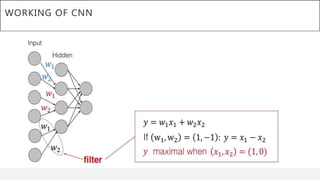

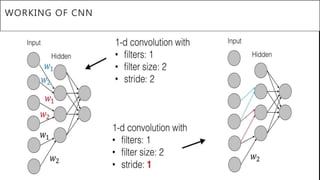















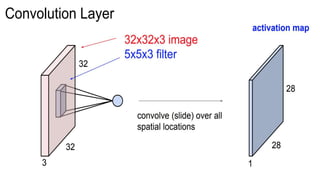





































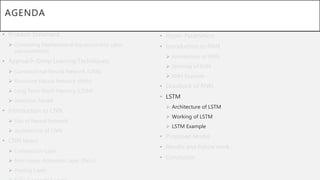















![REFERENCES.
[1] R. 1. Anderson, Syntax-directed recognition of handprinted mathematics., CA: Symposium, 1967.
[2] K. Cho, A. Courville and Y. Bengio, "Describing Multimedia Content Using Attention-Based Encoder-Decoder Networks," in IEEE, CA, 2015.
[3] A. K. a. E. Learned-Miller, "Learning on the Fly: Font-Free Approaches to Difficult OCR Problems," MA, 2000.
[4] D. Lopresti, "Optical Character Recognition Errors and Their Effects on Natural Language Processing," International Journal on Document Analysis and Recognition, 19 12
[5] WILDML, "WILDML," [Online]. Available: http://www.wildml.com/2015/09/recurrent-neural-networks-tutorial-part-1-introduction-to-rnns/.
[6] S. a. S. J. Hochreiter, "Long Short-Term Memory. Neural Computation," 1997.
[7] S. Yan, "Understanding LSTM and its diagrams," Software engineer & wantrepreneur. Interested in computer graphics, bitcoin and deep learning., 13 03 2016. [Online]. [1]
https://medium.com/@shiyan/understanding-lstm-and-its-diagrams-37e2f46f1714.
[8] C. R. a. D. P. W. Ellis, "FEED-FORWARD NETWORKS WITH ATTENTION CAN SOLVE SOME LONG-TERM MEMORY PROBLEMS," ICLR, 2016.
[9] a. F.-F. L. Karpathy, Image captioning., 2015.
[10] F. A. Gers, N. N. Schraudolph and J. Schmidhuber, "Learning Precise Timing with LSTM Recurrent Networks," Journal of Machine Learning Reserach, 8 2002.](https://image.slidesharecdn.com/thesisppt2-180112190155/85/Convolutional-Neural-Network-and-RNN-for-OCR-problem-94-320.jpg)





































































